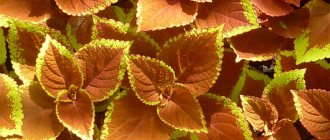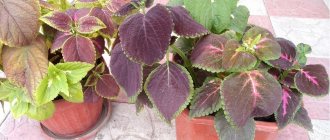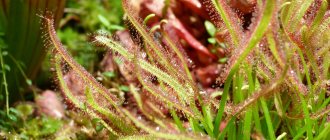Few plants can compare in brightness and variegation of leaves with Coleus Blume, which is popularly often called nettle, decorative nettle, and fire nettle.
A plant familiar to many today may not be recognized under a priority name unfamiliar in the world - Solenostemon scutelliniformes. However, when you see a picture of the plant, you will immediately recognize it as a coleus.
Nature has endowed its red, golden, lemon, monochromatic and bicolor, bordered, patterned leaves with such exquisite beauty that even the flower prima donnas themselves: roses and lilies, can envy it.
Coleus has a truly legendary past: once upon a time, at the very beginning of the 19th century, it was very popular as a houseplant, which was very highly valued because it decorated almost every balcony, and new varieties received the names of crowned heads. In the 20th century, it became cramped in pots on the windowsills of houses, schools, kindergartens, clinics, shops, libraries, and coleus “stepped” into the garden and flower beds.
Today, in the 21st century, with the appearance of coleus in flowerbeds, borders, mixborders, and containers, it is experiencing its next rebirth. Coleus is still loved, in demand and “hasn’t gone out of fashion.” Well, what qualities have allowed him to shine in the aura of glory for the 3rd century in a row?
Ads by
Coleus care
Coleus is not only very beautiful, but also grows quickly at home. It is also useful because the leaves contain natural phytoncides that purify and refresh the air.
Temperature
Coleus loves warmth, so it feels best at a temperature of 20 degrees. It will not survive the winter in open ground, so it is grown in the garden as an annual. In an apartment, coleus feels good at a temperature of 16 degrees. Be sure to make sure that even in frost it does not fall below 12 degrees.
Lighting
For coleus to be truly bright and unusual, it needs as much light as possible. Varieties with white, yellow or red leaves tolerate even direct rays well, unlike green and purple ones. If you have south-facing or east-facing windows, choose them.
Watering
For watering, be sure to leave the water for at least a day in a warm place so that it is slightly warmer than the air temperature. In summer, make sure that only the top layer of soil dries out, and in winter, reduce the frequency. But do not allow the coma to dry out completely, otherwise the leaves will react almost instantly and become painful. Coleus loves spraying, because it grows in a hot, humid climate. Even in winter, it is better that the humidity in the room is slightly increased - for example, as in the kitchen or bathroom. For spraying, use the same warm, soft water as for irrigation.
Soil and fertilizer
Coleus is absolutely unpretentious to the type of soil, so any nutrient mixture will do. At the beginning of the period of active growth, use mineral or organic supplements. Add a weakly concentrated solution once a week, and in winter - once a month and at half the concentration.
Reproduction
Coleus propagates equally well by seeds and cuttings, because it grows quickly. At the end of winter, scatter the seeds evenly in a flat box and do not sprinkle on top. Make long distances because they have a very high germination rate. Spray the soil with a spray bottle, set the temperature to 20 degrees and find a brighter place. The seedlings will germinate quickly, so don’t put off picking. If they no longer fit in the container, they may begin to wilt. To ensure that coleus bushes well from the first months, pinch it immediately after transferring it into a separate pot. Coleus cuttings are replanted in spring and summer due to the fact that the flower is very heat-loving. To do this, the branches are cut off at the end of winter and transferred to nutritious flower soil. If you put them in water, hurry up and transplant the cuttings immediately after the roots appear.
Coleus "Superfine Rainbow Multicolor"
Coleus "Superfine Rainbow Multicolor" (Superfine Rainbow Multicolor) is a unique variety with camouflage-like chaotic patches of salmon pink, bright yellow, grass green and dark red, mixing on each leaf in different extravagant combinations. Other varieties with multicolor ripples:
- Giant Exhibition Marble;
- Tickled Pickle;
- Fairway Mosaic;
- Stormy Weather;
- "Victoria";
- Paisley Shawl;
- "Anna"
Coleus 'Superfine Rainbow Multicolor'. Ludwig
How to propagate a culture - ways
Sooner or later, coleus will have to be propagated, as the bush will grow large and lose its decorative appearance. There are two ways in which the plant is propagated:
Cuttings - cutting off the tops and rooting them in a new pot.
Seed method.
How to cut a flower:
Cut off the apical shoots with leaves about 12 cm long.
Trim the bottom plates so that 6 cm is per shoot.
Place in water with a growth stimulator or stick into a peat-sand mixture.
After 1 - 2 weeks, roots appear - the cutting is ready for planting in good soil.
The question is when to plant coleus seedlings when growing from seeds: it is best to do this in the spring. The seeds have high germination even 3 years after collection. To grow seedlings, you need to organize a greenhouse, covering it with film.
When the leaves appear, the seedlings can begin to be fed with nitrogenous substances for growth. Typically, decorative specimens are obtained from your own grown seedlings by further cuttings. That is, first the seedling grows, then it is cut to get bright flowers.
Content Features
Caring for any variety of coleus is almost always the same. For successful growth and development of the plant, you should follow the following recommendations.
- When watering, it is necessary to monitor the moisture content of the top layer of soil. At high temperatures and insufficient air humidity, it is worth additionally spraying coleus leaves.
- The temperature of the room in which the coleus is located should not exceed +16°C.
- Fertilize the plant half a month after it is transplanted. During active reproduction, it is recommended to feed the flower every 1.5-2 weeks.
- The plant must be pruned every year with the onset of the warm season. The only rule for this process is to trim the shoots to 6-7 cm in height.
Thus, we can say that among the varieties of coleus, everyone can find something that is pleasing to the eye. In addition to using coleus alone, they can be combined with other plants: shade them or, conversely, play in contrast, using other flowers as a background.
See the following video for details of sowing coleus in different ways.
Growing coleus from seeds
It is not difficult to obtain unusually attractive coleus plants from seeds. Self-collected or purchased seeds produce a high percentage of seedlings, and young seedlings grow well.
Still, when growing coleus from seeds at home, several factors need to be taken into account.
Plants are quite light-loving and develop in consistently warm air. Therefore, to obtain strong, healthy seedlings, sowing is carried out in early spring, when daylight hours begin to increase. In this case, the seedlings are guaranteed not to be weak and elongated due to lack of sun, and their development occurs noticeably faster than in autumn or winter.
To grow coleus from seeds, you will need shallow containers with pre-made drainage holes. For sowing, take a light, very loose substrate with a high nutrient content. An example of such soil is a mixture of humus, sand, peat and crushed sphagnum. Backfilling is carried out almost without compacting the soil so that about 1.5–2 cm remains from the soil to the edge of the container.
Now you can proceed to sowing:
- Coleus seeds are very small, so they are not embedded in the soil, but only distributed evenly over its surface.
- Moisten the top of the planting with a spray bottle. This must be done extremely carefully, since even a stream of water can bury the seeds or lead to their crowding.
- The container is placed in a window greenhouse or placed under film.
When the seeds intended for growing coleus are placed in a nutritious, moist substrate, they require warmth and light. Therefore, the container should be immediately placed on a bright windowsill or artificial lighting should be provided for sowing. The optimal temperature for coleus is 22 – 24 °C.
Pest and disease control
If the leaves of indoor coleus begin to suddenly lose color, most likely they are not getting enough sun. But there is also the opposite problem: unexpected white spots can turn out to be burns. This happens more often with young, vulnerable plants that are not yet accustomed to their daily routine. Brown spots appear due to a lack of moisture in the air, so do not forget about preventive spraying. Unexpected leaf fall is a sure indicator of nutritional deficiency. And if the flower begins to stretch too high, it needs preventative pinching and additional lighting. Decorative coleus leaves are not very attractive to pests. But sometimes spider mites, whiteflies or aphids appear, so inspect the plants periodically. The affected flower must be urgently isolated from healthy ones and treated with insecticides.
How to plant coleus correctly?
Coleus flower has brightly colored leaves and compact size only when it receives enough sunny color. In the same case, when it is planted in the shade, it can turn pale, stretch out and largely lose its decorative qualities. Therefore, this culture is usually placed indoors on window sills facing south and east. However, coleus also do not like too much exposure to the sun, so they will need to be shaded during the afternoon.
If you have free balconies or terraces, you can place plants on them. There they receive a large amount of fresh air and are reliably protected from negative environmental factors. In this case, for planting it is necessary to choose spacious flower pots with a depth of 15 cm. They must have a drainage layer, as well as a drain hole. The soil for coleus should not only be light and loose, but also fertile with a slightly acidic or neutral pH. For example, in this case, you can use a soil mixture consisting of one part coarse sand and peat, and two parts compost.
Since coleus requires a lot of diffused lighting, it is better to grow it on a windowsill
In the summer, it will be good to take coleus plants out into the fresh air, which will accelerate their growth.
As for the propagation of coleus, this procedure is very simple due to the unpretentiousness of this plant. So, to prepare a large amount of planting material, it will be easiest for you to resort to growing cuttings. To do this, it will be necessary to prepare them in the summer or spring. This procedure is performed by cutting off young shoots that have reached a size of approximately ten centimeters.
Coleus propagate well by cuttings
Pre-prepared cuttings will need to be rooted in the ground or in wet sand. If this is not possible, you can put them in ordinary water, but the lower part of the cutting will need to be freed from the leaves. Typically, coleus are first planted in a pot, then covered with polyethylene. The seedling is slightly shaded and left to take root at a temperature of 18-20 ° C, after which the plant will need to be planted in its place of permanent growth.
If you decide to grow this representative of the flora from seeds, be prepared for the fact that adult plants will have unpredictable colors. In this case, the seed material is sown in March-April in boxes under glass. After 18 days, shoots should appear.
After planting coleus seeds, it is necessary to cover them with film, plastic or glass to ensure a microclimate
After the coleus seedlings grow a little, they need to be planted
So, the same dive will need to be carried out when the plants reach a height of ten centimeters. As a result, by summer powerful coleus bushes should have formed, which can later be transplanted into open ground, a container, or any other permanent place.
An incredibly rich palette of coleus leaves
In coleus varieties (Solenostemon) you can find the desired shade, if not in the main color, then in the details. The leaves are colored in metallic silver and copper, bronze and gold, cold emerald, all shades of green (from almost black to anise) and even bright pink-fuchsia, lemon yellow or orange, which is atypical for deciduous crops.
It is the rich color range that makes coleus an ideal “textile” plant, allowing you to select green accents to match the textures and fabrics presented in the interior. But the beauty of the velvety, wrinkled, surprisingly pleasant to the touch surface of the leaves should not be underestimated.
This plant even has a shape reminiscent of nettle leaves - which is not a necessary feature. Coleus leaves are lanceolate, heart-shaped, oval, large and small (from 2 to 20 cm in both length and diameter), wrinkled and smooth, embossed, with varying degrees of serrated edges (from serrated to crenate, serrated, deeply incised, wavy and scalloped) and even with lobed and feathery variations.
Hundreds of different variations of leaf shapes and colors are the main thing that attracts both gardeners and florists about coleus. None of the dozens of varieties that can be found in flower shops and garden centers can be called purely indoor or intended only for growing in open ground. Amazing plasticity, the ability to look equally good in pots, in flower beds, and in soil, makes coleus even more unique and desirable.
Types and varieties of hybrid coleus with photos and names
Coleus is valued for its unusually bright leaves: pink, burgundy, and gold. Hybrid varieties of this plant have leaves of different original shapes, with wavy and fringed edges. Coleus is used to create complex flower beds in combination with other crops. It is also used for decorative decoration of balconies and external facades of buildings. In this case, the plant is planted in large vases.
Hybrid coleus comes in short and tall varieties, with the latter most often grown indoors. Coleus is propagated both vegetatively and by seeds. Most often, both methods are used. First, in January–March, seeds are sown for seedlings. From the emerging seedlings, the most decorative forms of plants are selected, which are then propagated vegetatively.
The most decorative are the hybrid coleus: Yulke (dark red leaves), Gero (dark purple leaves) and Verschaffelti (dark red leaves with a green border).
Modern gardeners have developed new varieties of coleus: Superfine Rainbow, Masterblends Rainbow, Wizart, GiantLeaf, Dragon Sunset and Vulcano Mixt.
The most decorative varieties are considered Red Velvet, Somon Lace, Rosewood, Northern Lights.
Bloom's Coleus (Coleus blumei Benth.). Family Lamiaceae. Homeland - tropical Asia. Shrubby decorative deciduous plant.
Look at the photo - indoor coleus flowers of this variety have ribbed, tetrahedral stems; leaves are ovoid, pointed:
Numerous varieties have leaves of different colors: dark red, almost black, brown-yellow. There are emerald-colored leaves combined with yellow or red spots. The flowers are collected in small clusters, inconspicuous, lilac-lilac. Photophilous and thermophilic. In winter, at low temperatures, it sheds its leaves, often rots and dies. When there is insufficient light, the leaves lose their bright color.
In winter, coleus do not grow and are relatively dormant, so watering should be moderate - do not allow it to dry out. Coleus is planted in a light nutrient mixture composed of turf, leaves, humus soil and sand (4: 3: 2: 1).
Bloom's coleus can be used to decorate rooms and other interiors, for the external decoration of balconies and windows.
Popular varieties
Low and dwarf varieties of marigolds are among the most popular and considered the best for flower beds. Also, similar plants are planted on lawns and borders and used as living decorations for balconies and loggias. Let's look at the most popular varieties and get acquainted with their names.
"Mandarin". This variety got its name due to its bright orange color, similar to the color of the popular citrus fruit. The length of the marigold bush of the “Mandarin” variety reaches 30 centimeters, and by its nature it is a hybrid. "Mandarin" blooms in the warm season.
Thus, there is a huge variety of varieties of marigolds, so each homeowner will not have a difficult time choosing the right one for individual needs and in accordance with personal preferences. Combinations of colors of different shades will look especially beautiful. For example, in your garden plot you can create an unusual color palette: from white marigolds to flowers painted in rich orange shades.
| Marigolds erect Description:
Varieties:
|
| Marigolds are stunted, rejected Description:
Varieties:
|
| Marigold thin-leaved Description:
Varieties:
|
| Perennial varieties Description:
Varieties:
|
| Terry marigolds Description: double species are formed by a large number of reed and tubular flowers located on small bushes Varieties:
|
| Chrysanthemum-shaped Description: the inflorescences practically consist of tubular flowers; the variety was bred from erect marigolds Varieties: Taishan is a low-growing bush covered with large orange inflorescences. Flowers in diameter 60-80 mm |
| Dwarf Description: this group includes all of the above types. The height of the bush does not exceed 20 cm Varieties:
|
Where is the best place to put it?
Coleus is perfect for enlivening space in the southern and southeastern parts of the room.
It will not only add a note of novelty and freshness, but will also serve to stimulate energy flows in the corners of the room. An excellent location for the plant is the bedroom. Coleus will not only relieve unpleasant thoughts, but also improve the sleep of its owners. Its strong and pure energy can have a positive impact on the intimate side of the life of a married couple.
Fire nettle in the hallway is a protective barrier against guests with evil thoughts. It acts as an indicator of envy and hatred. Evidence of bad intentions will be the drooping leaves of the plant in a matter of minutes.
Coleus is an amazing plant that carries positive energy, overshadowed by the negativity of superstition. Therefore, it is better to grow a flower in an office or garden. But, no matter where it is, you should know: nettle belongs to the category of vindictive and vindictive plants. She does not forgive indifferent attitude and poor care.
Coleus propagation
Coleus is propagated in open ground in 3 ways:
- seeds;
- seedlings;
- cuttings.
Coleus seed propagation
Coleus seeds
It is better to purchase seeds in a licensed store or shopping centers.
Coleus is a southern, heat-loving plant that dies already at +12°C. For seedlings to appear, the temperature must not be lower than +20..+24°C. Coleus plants, when properly cared for, quickly grow leaf cover. Plants require fairly high temperatures for rapid growth and development. Therefore, seed propagation is rarely used and only in fairly warm southern regions. The most common is planting in open ground through seedlings.
Growing seedlings
Coleus seeds are small, reminiscent of poppy seeds, so sowing is carried out in specially prepared cassettes with a light, water- and breathable, nutritious substrate. Sowing period - March, April. The time for sowing seedlings is linked to the onset of constant warm weather in the region (not lower than +19..+20°C).
Soil preparation
For sowing, you can buy ready-made soil or create a soil mixture yourself. The acidity of the substrate is neutral, pH+6-7 units. For the substrate use:
- 4 parts leaf soil;
- 2 parts turf or fine mature humus;
- 1 part sand or perlite, vermiculite.
Sowing
The prepared soil is moistened and left to mature for 2-3 days (slightly damp and crumbly to the touch). The seeds are laid out on a flat surface and sprinkled with sand or fine substrate in a layer of no more than 3-4 mm. Spray from a small spray bottle and cover with film. Place the container with the seed in a dark place with a temperature of +20..+25°C. The soil is moistened as necessary. The improvised greenhouse is ventilated daily so that drops of moisture do not clog the crops.
Seedling care
Coleus seedlings
- If the agrotechnical care requirements of coleus are observed, the first shoots of seedlings appear on the 8-10th day.
- During mass shoots, the cover is removed from the container and placed on a windowsill with sufficient but diffused lighting. The temperature is maintained at +17..+20°C.
Coleus shoots from seeds
- By the end of 3-4 weeks, the plants unfurl their first pair of leaves. During this phase, densely sown plants are planted in other containers with sufficient soil level.
- The soil is kept constantly moist. Watering must be done with soft, settled, warm water.
- At 6 weeks from germination (about 10 cm in height), the pickling is planted in separate containers (cups), where it develops before planting.
Coleus seedlings in separate containers
- When transplanting, pinched seedlings are pinched so that the plants do not stretch out, but form a bush-like shape.
- Before watering, you can fertilize with flower fertilizers in half the dose (recommended).
- Seedlings are ready for planting 6-7-8 weeks after mass germination
- If warm weather lingers and the cups are small in volume, the seedlings can be transplanted again into larger containers.
Growing and care
Before planting coleus in the soil, it is necessary to create the most favorable conditions for it. The plant should be planted in open ground in April - at this time there is still no intense heat, but the weather is quite warm.
Caring for indoor Blume does not involve anything complicated. Since the plant loves good lighting, it should be placed on any window, with the exception of the northern one. The correct lighting determines the uniqueness of the leaf colors, as well as the splendor of the subshrub. Lack of lighting will cause faded foliage and excessive elongation of the plant.
The optimal temperature for indoor nettles is 23-25 degrees Celsius.
When it's hot outside, you shouldn't let the coleus stems and leaves dry out. That is why in hot summers, in addition to regular and abundant watering, it is also worth spraying. It is worth noting that a lack or excess of moisture can lead to drying out and falling of the foliage. In winter, watering should be done once a week, but the best option would be to constantly monitor the condition of the soil.
During the winter months, coleus needs to be fed once every 30 days. During the warm period of the year, namely in spring, summer, and autumn, it is worth fertilizing the semi-shrub once a week. Nettles need nitrogen to grow properly. The best option for the plant is a complex fertilizer, which is sold in stores.
Notes
Coleus Blume is suitable for tree shaping
It doesn’t matter whether you start forming with small seedlings or later. You can start with a plant chosen for overwintering to get cuttings for next year
In any case, you need to decide and choose one fairly simple escape. From the old plant, the lower leaves and side shoots are simply removed to the required height, selecting the cuttings used for seedlings, the lower leaves are removed from the cuttings, and, if necessary, transplanted into a larger pot. When forming an older plant, like seedlings, a bamboo stick is installed, placing the support closer to the trunk. For an older plant, we attach the support moderately loosely, in several places, around the seedlings, as the shoot grows, systematically removing the lower leaves, possibly side shoots.
When the coleus grows to a height of 80-90 cm, it is necessary to either replant it or place the pot in a large container to maintain balance. Leave the trunk height at about 60 cm, constantly cutting off the gradually growing shoots. Then all side shoots and the main shoot are cut off. Emerging shoots are cut off again behind the second pair of leaves. The shoots do not grow too evenly; they are pruned to maintain the shape of the tree crown. During the entire time, everything is removed from the trunk, up to complete woodiness. A formed tree can live for several years under favorable storage conditions, or in February-March you can choose another specimen for formation.
Coleus care
Temperature:
in summer it is ordinary, indoor, although in general, coleus prefers a moderate temperature range from 18 to 22°C; the hotter the weather in summer and the dryer the air, the faster the coleus grows and elongates. Because of the heat, the leaves at the bottom of the stems quickly dry out and fly off, and the plant loses its decorative appeal. In winter, the temperature is preferably cool, around 15°C, i.e. such that there is no plant growth. Winter minimum 10°C.
Lighting:
Coleus is light-loving; bright leaf color is possible only in good lighting. Requires bright diffused light, with shading from direct sunlight in the summer during the hottest hours of the day. Ideally, direct sun should hit the plant in the morning before 11 a.m. or in the evening after 3-4 p.m. These are windows with east or west (northwest) orientation. You can place Solenostemon on a south window, but under shade. And here it is not so much the direct sun that is dangerous as the heat - on southern and western windows the temperature rises above 40°C. Therefore, on hot days it is better to move the plant to a cooler place.
Watering:
In summer, coleus is watered abundantly; due to dryness, the leaves droop and then dry out. Therefore, the soil in the depths of the pot, where the bulk of the fibrous roots are, should be slightly moist all the time, but the top layer of soil should have time to dry out before the next watering. In autumn and winter, watering is reduced, its frequency depends on the temperature, but the soil should dry out in the upper half of the pot.
Fertilizers:
Coleus is regularly fed with fertilizers from March to September, once a week - ten days. You can alternate mineral fertilizers with organic ones (preferably based on horse manure). By the way, despite the fact that Coleus is an ornamental deciduous plant, the color of the leaves is richer and brighter if it is fed with fertilizer for flowering plants (fertika-lux, uniflor-bud, pokon for flowering, etc.).
Air humidity:
Coleus loves moist air, but does not need spraying during the growing season. Only dry air in a warm room in winter is harmful to the plant, therefore, if Solenostemon overwinters in a room, it must be isolated from the directed warm air of the battery.
Transfer:
annually in the spring. Soil - any nutrient mixture, coleus is not picky about the composition of the soil, acidity from slightly acidic to neutral, but not alkaline. You can take 3 parts of garden soil, add 1 part of well-rotted compost and 1/2 part each of sand and vermiculite. It is necessary to pour drainage (for example, large expanded clay or polystyrene foam) into the bottom of the pot or container. If the soil has become too compacted from watering, loosen the soil periodically.
Solenostemon is a fast-growing plant, but its disadvantage is that it also grows quickly and ages. The stem becomes lignified, first of all, in the lower part, gradually becomes bare, and the plant loses its attractiveness. Abundant flowering also contributes to this - it depletes the plant. Since the flowers are not at all attractive, it is better to break off the flower stalks immediately.
Solenostemon is a perennial plant, but one bush is usually not grown for more than two years - this is impractical (only young bushes are beautiful). Of course, you can radically cut off the old coleus in the spring, and young shoots will form stumps, but in this case, when replanting, the trunk must be buried a little into the ground, and the lower part of the root ball must be cut off.
Conditions without which bright coleus cannot be grown
No matter how undemanding this plant may seem, without suitable conditions and regular care it will not be possible to fully realize the full potential of the variety and enjoy the beauty of its leaves. In order not to be disappointed in extravagant coleus, it is worth remembering a few basic requirements:
- The brightest varieties of coleus are more light-loving than their less original counterparts; they need to be provided with diffused but bright light - without the risk of sunburn in the height of summer, but also without strong shading, in which patterns and textures will disappear.
- In the garden, coleus will prefer cool places, in rooms - cool and stable. But you shouldn’t abuse the plant’s stamina - stable temperatures, protection from drafts and cold winds will allow the greenery to become even more beautiful.
- The soil for coleus should be loose, breathable and nutritious.
- After planting, coleus are fed every 2-3 weeks with fertilizers for decorative foliage plants. Long-acting fertilizers can be used for indoor plants.
- Coleus do not like droughts and dampness; water the plants often, but without excess, allowing the soil to dry out.
- The leaves of the plants should not get wet; excessive spraying and showering will destroy the coleus.
You should not forget about pruning for any coleus. To enjoy the beauty of the leaves, you need to prevent flowering, pinch the tops in time to thicken them, and keep the bushes in shape all the time, preventing the shoots from stretching and dry and damaged leaves from accumulating. Coleus easily tolerate even heavy pruning. Constant cleaning and good hygiene are the best preventative measures to keep your coleus plants healthy.
Coleus are very variable. No matter how hard you try to create optimal conditions, you should be prepared for the fact that coleus will differ from the “ideal” - a sample of the characteristics of the variety. The thing is that even small changes in temperature, air humidity and lighting change both saturation and shades. Each variety of coleus is not only unique, but also always different in different rooms and places. Two bushes can be different even on the same windowsill!
Brief description of Coleus
From a biological point of view, the Coleus plant is a shrub and belongs to the Lamiaceae family. Its distinctive feature is the presence of tetrahedral stems, as well as opposite broad-oval leaves, along the edges of which there are teeth. The tropical regions of Asia and Africa are considered the homeland of Coleus.
Coleus shoot structure
In appearance, this shrub is very similar to another plant - Croton, which is why it is sometimes called poor man's Croton. As for its color, among the existing varieties, most plants have patterned velvety leaves in light green, deep red, brown, dark purple and white. Veins on the foliage, darker in color, create original images on the leaves of plants in the style of African primitive art.
Today there are more than 150 varieties and varieties of coleus, and they include both annual herbaceous plants and evergreen subshrubs. All coleus leaves have different colors; they can be patterned or opposite. Of these, Coleus bloome is the most widely used in landscape design and interior design.
The island of Java is the birthplace of coleus
There is a wide variety of coleus plants
The island of Java is considered the homeland of Coleus, and it was on the basis of specimens taken from there that the variety of hybrids of this Coleus that exists today was created. The average height of this shrub is 30-40 centimeters. Moreover, most forms of this plant have leaves that resemble nettle foliage in appearance. They have folded or wavy edges, and their plate itself is corrugated. Both single-color and multi-colored hybrids of Coleus bloome are common in everyday life.
Currently, the varieties Colosseus nanus and Laciniatus have become actively used for home cultivation. They are quite rare and are propagated by cuttings. They are distinguished by the extraordinary beauty of their leaves. If you want to grow carpet varieties, then you should purchase planting material of the Gero and Yulyuke varieties.
Most species of these tropical plants, due to their unpretentiousness, get along well in the middle zone, and they are grown both indoors and outdoors. For example, a pot of coleus can be placed on a terrace, balcony or windowsill. In open soil they are used both for independent cultivation and for creating landscape design compositions.
Coleus "Premium Sun Chocolate Covered Cherry"
Coleus "Premium Sun Chocolate Covered Cherry" (Premium Sun Chocolate Covered Cherry) is a unique late-flowering variety that retains its decorative effect for a very long time with a raspberry-pink feather in the center of the leaves, emphasized by an uneven dark cherry border and a thin, affecting only rounded cloves at the edges, with bright light green border. The wavy edges somewhat spoil the heart-shaped shape, but the bushes are densely branched, they are compact, suitable for borders and containers. Other varieties of coleus with a play of pink, cherry and bright green:
- "Prince Bishop"
- Bleeding Heart;
- "Heartbreaker"
- “Superfine Rainbow Color Pride”;
- “Watermelon”;
- "Kong Rose"
Reproduction methods
Coleus Blume is a type of plant that can be easily grown from seeds. You can buy them in a specialized store. Sowing of coleus should be done in March, as there is a large amount of sunlight at this time. The container with the material sown in it must be placed on a sunny windowsill.
Sow nettles in a flat oblong container, the soil should be moist. After sowing is completed, it is worth covering the container with film, thus creating a greenhouse effect. The florist must remember that the distance between seeds must be at least 5 cm.
If there is not enough time to propagate Blume by seeds, you can use another method. Propagation by cuttings is carried out by placing the plant in a pot filled with substrate and then transferring it to a warm room. To increase the speed of rooting, it is worth covering containers with cuttings with film.
Ready cuttings can also be placed in a glass of water, waiting for roots to appear. When the young coleus is ready to take root, it should be transplanted into the soil. If you want to get a lush planting, you can plant several cuttings in one pot. This way, gardeners get a mixture of colorful leaves in one container.
general information
The colloquial name for coleus, which it received for the expressive shape of its leaves, is weed. In the apartment the flower grows like an unpretentious perennial, but in the garden it will not survive the winter. And all because in nature it lives in Africa and Asia - regions with hot climates and the absence of frost. Coleus was brought to Europe on purpose and they immediately began to breed it. The first wild species amazed sailors so much that they brought them straight from the island of Java. So, since the nineteenth century, the popularity of the flower in the world has grown rapidly.
Coleus leaves can be the most unexpected colors: orange, red, burgundy. Most often, they combine several shades at once: for example, grassy green with purple. Together with the unusual shape of the plates, this looks very impressive and exotic! Although this does not worry flower growers too much, coleus has flowers. They are just small, faded and inconspicuous, whitish or blue. They are not particularly attractive, so it is better to remove the buds at the bud, otherwise they will draw almost all the nutrients onto themselves. Because of this, during flowering, the coleus leaves become smaller and fade.
Peculiarities
Coleus Blume is a representative of bright ornamental plants, the main feature of which can be called the aesthetic value of the leaves, rather than the flowers. The foliage of the plant is characterized by a velvety texture and is painted in different color shades. This representative is considered an indoor dweller, but can also feel great in the garden.
The perennial plant belongs to the Clear-flowered and Lamiaceae; it has a fleshy stem, which becomes woody over time. Coleus Blume can reach 0.1-0.8 meters in height. The dimensions of the flower are influenced by the characteristics of its care. Each type of variety has a different shape of foliage, which can be elongated, oval, heart-shaped and have jagged edges. The color of the foliage of the subshrub varies; it can be brown, red-burgundy, dirty orange and even almost black.
The flowering period of the subshrub occurs in the spring-summer period, at which time lilac-lilac small flowers with a two-lipped corolla and a spike-shaped inflorescence appear on the coleus. Blume is also popularly called indoor nettle, due to the characteristic shape of the foliage.











